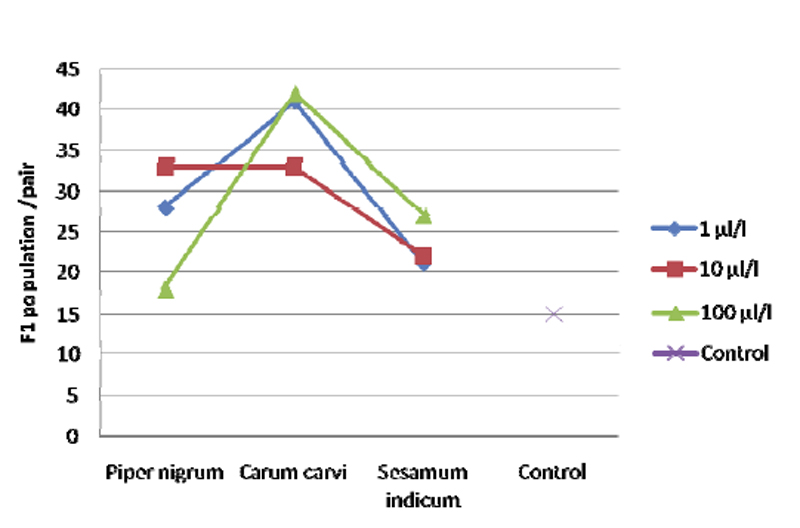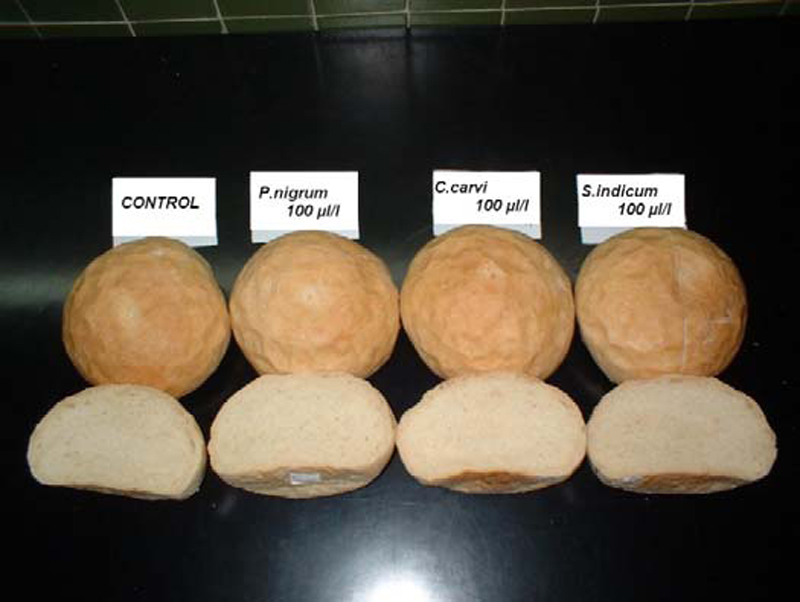ABSTRACT
Abstract
The aim of the study was to investigate the insecticidal activities of different doses of plant extracts obtained from Piper nigrum, Carum carvi and Sesamum indicum against rice weevil Sitophilus oryzae L. in wheat originating from organic certified production including the control of trading, rheological and baking properties of treated wheat. The ethanol extracts were applied on wheat kernel using microaplicator after which they were contaminated with 20 imagoes of Sitophilus oryzae L. The extract of P. nigrum was found to be the most efficient causing the highest mortality rate. It was shown by the baking tests that bread made from the treated wheat did not absorb the aroma of plant extracts.
INTRODUCTION
Stored-product insects destroy approximately 5-10 % of stored products (Christensen,1974; Vukasović et al.,1972). Rice weevil is considered to be one of the most dangerous pests found in stored wheat in our country as well as other countries (Almaši et al., 2003). Beside great economic losses, insects also cause qualitative losses in raw materials and end-products (Bodroža Solarov et al., 2004).
Pest management of certified organic commodities is limited to the use of natural preparations and technologies that do not disturb the basic principles of organic production. The potential alternative to insect-control agents which meet the requirements of organic principles may be provided from plant extracts and aetheric oils. Plant extract and essential oils are very complex natural mixtures which can contain about 20–60 components (alkaloids, amides, pyrones, dihydro-chalcones, flavonoids, phenylpropanoids, lignans) at quite different concentrations (Bakkali, et al., 2007; Autran, et al., 2008).
Plant extracts contain compounds that show ovicidal, repellent, antifeedant, and toxic effects in insects (Isman, 2006). It was reported by Soon-Il Kim (2003) that direct treatment of adult insects from population of rice weevil with aetheric oils showed toxic contact activity.
So far, only few papers have dealt with the efficiency of plant extracts directly applied on stored commodities in the pest control. Also, a small number of studies has focused on the changes of nutritive and sensory attributes of treated stored commodities which is interesting considering the intensive odor and aroma plant extracts and essential oils exert (Rajendran and Sriranjini (2008).
This paper investigates the potential of plant extracts obtained from Piper nigrum, Carum carvi and Sesamum indicum applied at different doses to control rice weevil (Sitophilus oryzae L.) in wheat. The paper also examined the effects of the extracts on the basic quality traits of wheat (trading quality parameters and baking potential).
MATERIAL AND METHODS
The experimental material was mercantile wheat (Triticum aestivum), harvested in 2003. Prior to the experiment, the wheat impurities had been removed.
Cultures of S. oryzae L. were maintained in the entomology laboratory of the Faculty of Agronomy at Novi Sad, on wheat grain at 27 ºC. The age of imago used in the experiment was over one month.
Extract preparation
Firstly, grinded grains of Piper nigrum, Carum carvi i Sesamum indicum were defatted with n-hexanal. After that the samples were extracted with 96% aqueous ethanol for 6 hours. The obtained extracts were filtered through qualitative filter paper. Each extract was concentrated by rotary evaporation. For further investigation, each extract was dissolved in 20 ml ethanol.
Setting the bioassay
The weight of wheat used in one treatment was 1 kg. All treatments were replicated four times. The following doses of pepper, caraway and sesame extracts were applied: 1, 10,100µl/kg. The control sample was treated only with 20 ml ethanol. The extracts were applied on wheat grain by microaplicator (Potter Spray Tower). After 24 h, groups of twenty weevils (10 males and 10 females) were put in the treated wheat samples.
Estimations of eddiciencies of plant extracts
The number of insects and mortality percenttages of F1 generation were determined 66 days after the experiment has been set. The number of insects was determined by counting the number of imagoes and subtracting twenty from the sum in order to correct the result for the initial number of insects at the beginning of the experiment. The efficiency of plant extract was determined according to Shneidre Oreli (1947).
Wheat quality assessment
The trading quality parameters (test weight, moisture content and the number of grains damaged by insects) were determined in the accordance to the standard methods used in our country (Methods for physical and chemical analyses in the control of cereal and bakery products, 1988).
Bread was baked from control wheat flour and wheat flour made from treated wheat with plant extract with the highest concentration using a rapid mixing procedure as described in Kaluđerski and Filipović (1990). Sensory evaluation was carried out by 3 trained panel assessors, 24 h after baking.
Statistical analysis
Analysis of variance was used to check the significance of differences between treatments. The least significant difference (LSD) method for comparison of means was performed with a critical value of P=0.05 using the GLM procedure in SAS (Statistical Analysis Systems, Cary, NC).
RESULTS AND DISCUSSION
Ten adult pairs of Sitophilus oryzae L. were put on the wheat sample 24 h after treatment with plant extracts. According to data presented in Figure 1, it could be concluded that all applied extracts induced females of Sitophilus oryzae L. to lay more eggs as compared to control sample. The largest descendant (F1 generation) was observed in the sample treated with 100 µl/l C. carvi (42 images per 1 pair).

Fig.1. Descendants (F1 generation) of one
Sitophilus oryzae L. Pair
The efficiency of plant extracts was estimated 66 days after the exposure. Since rice weevil may live for 4-7 months in nature (Korunić, 1990), the experiment proved that the plant extracts affected the mortality of descendants.
Table 1. Efficiency of Plant Extract (%) on Sitophilus oryzae L.
Treatment |
Efficiency of plant extract (%)
mean ± SE*
|
|
Control
|
|
|
P. nigrum 1 µl/l
|
65,1± 6,7
|
|
P. nigrum 10 µl/l
|
66,8 ± 15,8
|
|
P. nigrum 100 µl/l
|
78,2 ± 13,7
|
|
C.carvi 1 µl/l
|
25,2 ± 33,7
|
|
C.carvi 10 µl/l
|
47,0 ± 17,5
|
|
C.carvi 100µl/l
|
45,0 ± 23,2
|
|
S.indicum 1 µl/l
|
67,4 ± 21,2
|
|
S.indicum 10µl/l
|
51,6 ± 18,3
|
|
S.indicum 100µl/l
|
43,4 ± 37,0
|
|
LSD P = 0.05
|
26,3
|
The lowest efficiency was observed in the sample treated with caraway extract, ranging from 25.2 to 47 %. No significant variation between the efficiency and dose was found. The highest efficiency was determined in the treatment with the 100 µl/l of P. nigrum extract (78.2 %). Although rated as high efficiency, it would not be enough for the control of stored wheat in practice (Tab. 1). The percentage of plan extract achieved in the treatment with S. indicum is in inverse proportion with the applied dose which implies to testing doses below 1 µl/l (Tab.1).
Table 2. Physical investigation of wheat kernels treated with plant extracts
Treatment |
Test weight (kg/hl) mean ± SE*
|
Moisture content d.b.(%) mean ± SE*
|
Damage kernel (%) mean ± SE*
|
|
Control
|
80,7 ± 1,28a
|
10,4 ± 0,18a
|
1,1 ± 0,08a
|
|
P. nigrum 1 µl/l
|
81,3 ± 1,09a
|
10,6 ± 0,28a
|
0,9 ± 0,04ab
|
|
P. nigrum 10 µl/l
|
80,9 ± 1,27a
|
10,6 ± 0,16a
|
1,3 ± 0,05a
|
|
P. nigrum 100 µl/l
|
81,7 ± 1,31a
|
10,3 ± 0,25a
|
0,5 ± 0,09b
|
|
C.carvi 1 µl/l
|
80,9 ± 1,35a
|
10,8 ± 0,18a
|
1,0 ± 0,08a
|
|
C.carvi 10 µl/l
|
80,9 ± 0,95a
|
10,6 ± 0,27a
|
1,2 ± 0,05a
|
|
C.carvi 100µl/l
|
81,1 ± 1,28a
|
10,5 ± 0,28a
|
0,8 ± 0,11a
|
|
S.indicum 1 µl/l
|
81,5 ± 1,07a
|
10,6 ± 0,45a
|
0,9 ± 0,13a
|
|
S.indicum 10µl/l
|
80,7± 0,82a
|
10,6 ± 0,23a
|
0,7 ± 0,15ab
|
|
S.indicum 100µl/l
|
80,9 ± 0,52a
|
10,6 ± 0,42a
|
0,9 ± 0,09ab
|
|
LSD 5%
|
1,35
|
0,49
|
0,44
|
*Means within a column followed by the same letter are not significantly different at P=0.05. Means (±SE) of untransformed data are reported
Physical parameters of wheat grains treated with the plant extracts are displayed in Table 2. The test weight ranged between 80.7 kg/hl to 81.7 kg/hl and did not represent significant variation as compared to the control. The variation in the moisture content between the control and the treated grains was not significantly different, too. The lowest mean content of insect damaged grains (0.5 %) was found in the samples treated with 100 µl/l P. nigrum which correlated well with the highest mortality found in the treatment. The difference in the content of damaged grains between this treatment and the control was statistically significant.
Table 3. Physical and sensory properties of bread made from wheat treated with plant extracts
Descriptive parameter |
Bread samples
|
|
Control
|
P. nigrum 100 µl/l
|
C.carvi 100µl/
|
S.indicum 100µl/l
|
|
Crust color
|
Golden, slightly glazed
|
Light golden, slightly glazed
|
Golden, slightly glazed
|
Golden, slightly glazed
|
|
Physical properties of crust
|
Thin, crunchy
|
Thin, crunchy
|
Thin, crunchy
|
Thin, crunchy
|
|
Flavor
|
Pleasant, archaic
|
Pleasant, archaic
|
Pleasant, archaic
|
Pleasant, archaic
|
|
Loaf specific volume, ml/g
|
3.54a
|
3.55a
|
3.49a
|
3.51 a
|
|
Bread yield, g
|
164.0a
|
159.5a
|
163.0a
|
165.4a
|
Mean values in the same column followed with different letters are significantly different (p<0.05).
Similar results were reported by Almaši (2003) and Bodroža-Solarov (2004) according to whom 8% damaged grains caused significant reduction in the test weight.
The baking potential of treated wheat was examined by the most objective method-test baking. The physical and sensory attributes of bread made from the treated wheat is presented in Table 3. The bread yield andspecific volume obtained for treatments with maximal dose of extracts did not significantly differ from the control. Moreover, the differrence in the sensory properties of bread made from treated wheat was not significantly differrent from the control. The taste was estimated as archaic or typical for standard white bread. The appearance and colour of bread were not affected, too (Fig.2). On the basis of these results, plant extracts might be useful in the protection of stored wheat.

Fig.2. Bread baked from wheat treated with plant extract
CONCLUSION
The highest extract efficiency of 78.2% found in the study with P. nigrum at dose 100µl/kg. cannot be considered as sufficient for large-scale application in the pest control of stored grains. Therefore, further research is needed to select plant extracts and proper doses.
The results of baking tests demonstrated that sensory properties of bread were not affected by neither of treatments which suggests that the extracts have potentials as alternative fumigants for stored-product pest control.
ACKNOWLEDGMENTS
The authors gratefully acknowledge the financial support from the Ministry of Science and Environmental Protection of the Republic of Serbia (Project TR 20066).
Download full article PDF
 DOWNLOAD PDF
DOWNLOAD PDF




